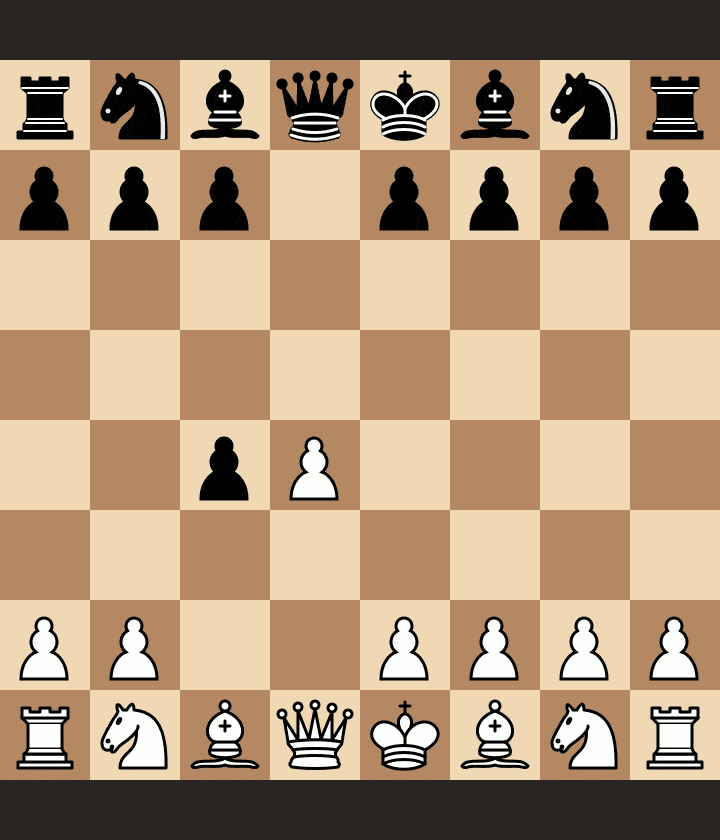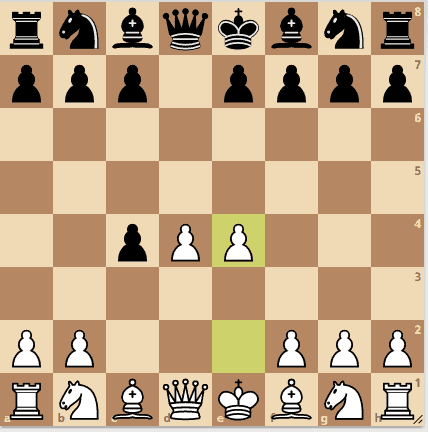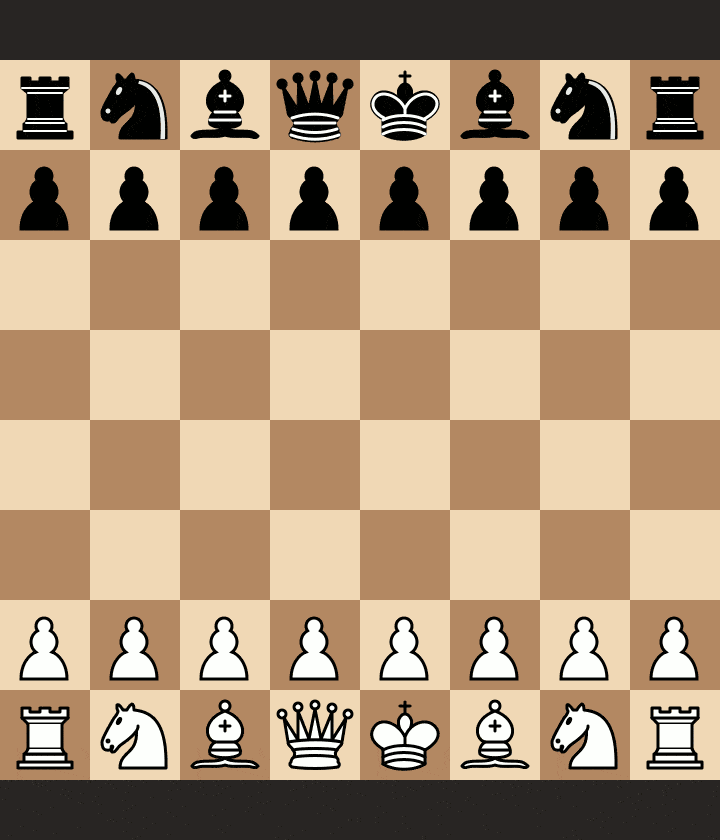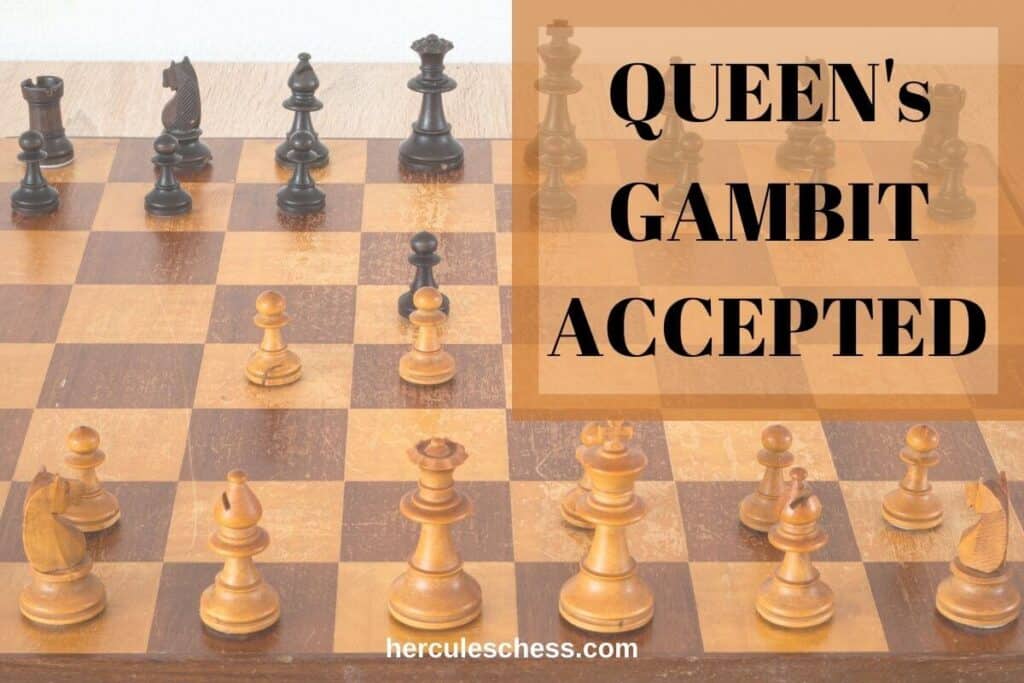The Queen’s Gambit begins with the moves pawn 1.d4 d5 2.c4. The Queen’s Gambit is a gradual strategic opening in which White is aiming to get a slight advantage and space in the beginning phase of the game and only later gradually develop it into an attack.
How To Play The Queen’s Gambit Accepted?
After the moves pawn to 1.d4 d5 2.c4, White is threatening to gain a central pawn majority and extra time with this move cxd5.
It’s natural to ask “What happens if Black accepts the gambit with 2…dxc4?” In fact this is no longer a very popular option but it’s still quite viable and it’s known as the Queen’s Gambit Accepted or the QGA for short.
Starting position of the Queen’s Gambit Accepted

This is exactly what I would be discussing in this article. The very first point that every good chess student should know is that Black can NOT hold onto the pawn.
For example after the move pawn 3.e3 Black would be in bad shape if he tried to hold onto this pawn with the move pawn to 3…b5.
White wins the pawn back by playing 4.a4. And if black plays 4…a6 then 5.axb5 wins for White since there is a pin.

If Black were to try 4…c6 he would actually run into a really nasty trap here. 5.axb5 cxb5 6.Qf3
Attempting to gain a whole rook. Black has no choice but to give up a Knight here with 6…Nc6.

So this is a really bad idea for Black and because of ideas like this, Black actually doesn’t try to hold onto the pawn on c4.
He’s accepting this gambit but only temporarily. White will be able to recapture the pawn.
Strategies In The Queen’s Gambit Accepted
Right away there’s a couple interesting questions which arise. If Black knows that White will eventually be able to recover the pawn on c4 why does he play the Queen’s Gambit Accepted? Isn’t it a good idea to hold onto our Central Pawns and not trade them for Flank Pawns?
A second question which might arise is “Why doesn’t White go ahead and occupy the square e4 immediately with his pawn as opposed to e3?” This is another interesting question and in describing the answers to these two questions we’re going to gain some real strategic insight into the Queen’s Gambit Accepted.
First let’s talk about why Black chooses to play the Queen’s Gambit Accepted even though White will eventually recover the pawn.
Black’s Strategy
Black’s strategy is to avoid getting bogged down in defending the d pawn so that he can devote his efforts to attacking White in the center with a counter-break of his own which is generally pawn to c5.
Since Black hasn’t spent any time defending the d5 pawn he keeps his options maximally open to strike at White’s center at the first convenient moment.
An excellent example of this occurs in the main line after 3.Nf3 Nf6 4.e3 e6 5.Bxc4 c5

This is really interesting because if you think about it Black is applying the exact same strategy as White did on Move Two. White played c4 to attack Black’s D Pawn and now later it turns out Black’s applying the exact same strategy.
He’s using his C Pawn to attack White’s D Pawn. In fact if White also plays 6.dxc5 Bxc5 you’ll see that we get to exactly symmetrical structure both sides have played the exact same moves with their pawns.
What we’ll often see though is White sometimes does choose to take on c5 leading to the symmetrical formation or he waits for Black to capture on d4 (cxd4) and accepts an isolated pawn in exchange for peace activity and extra space. This second strategy is a bit more popular than capturing on c5 with 6.dxc5.
White Plays 3.e4

We’ve begun to touch on our second question which is “Why doesn’t White just go ahead and occupy the e4 square with his pawn after Black played 2…dxc4?”
As we just saw White is anticipating Black is going to attack the d4 square with Pawn to c5. For this reason we’re reserving the E Pawn in case we want to play Pawn to e3 as we often do.
This doesn’t mean that 3.e4 is a bad move it just has some drawbacks which is that both of the pawns might end up being vulnerable.
They can be struck at with various pawn breaks or even peace activity as we’ll get a chance to see in a moment.
After the aggressive move 3.e4, Black has four moves which allow him to tickle some of these weaknesses which White has in the center.
The most direct move is Pawn to 3…e5 going straight for the d4 point right away. Ideally White would want to continue with 4.dxe5 or advance the pawn, 4.d5, but they both lead to an absolute mess here.
For example 4.dxe5 and now Black’s going to rip the Queens off the board with 4…Qxd1 and remove Castling rights from White.

Black shouldn’t really have any problems recovering the e5 Pawn. This is already an unpleasant situation for White.
The King is floating around in the center and we’ve lost control over the position very quickly.
The other idea you might end up with then would be to advance the pawn to d5 (4.d5) but now the pawns are fixed and they become really easy targets for Black.
Play continues with 4…Nf6 5.Nc3 c6 6.Bxc4, and it looks like maybe we’ve consolidated things.
Maybe we’ve held onto some advantage here but Black has a great maneuver here. He just plays 6…b5.
We can’t afford to put our Bishop anywhere but b3 because we’ve got to keep observation of the d5 pawn. But after 7.Bb3 b4, white central pawns are looking very shaky.

It’s going to be very difficult to find a way for White to find adequate compensation for this attack on his center.
It’s very difficult to play in these ways but theory suggests that White is doing okay and maybe even still has a slight advantage if he just plays 4.Nf3.
I want to emphasize again this position is perfectly viable for White It’s just not the most popular classical way for White to play against the Queen’s Gambit Accepted.
3.e4 Nf6
To give you some other ideas let’s look at 3…Nf6 attacking the e4 Pawn. This is baiting White into playing 4.e5 as he quite often does.
Now play often continues 4…Nd5 5.Bxc4 Nb6 6.Bb3 Nc6 7.Nf3 , Black’s ready to pin us and continue the attack on the pawn with 7…Bg4

Final Verdict – Should You Play The QGA?
There are some other popular and interesting ways for White to play against the Queens Gambit Accepted.
But I hope that in this article we’ve managed to look at some of the most important ones and get a really good idea for some of the strategic content of the Queen’s Gambit Accepted.
The Queen’s Gambit Accepted is a viable alternative for players who want to play very solid for Black, who are okay with defending patiently and waiting for the opponent to go a little bit wrong as there are definitely some chances for Black to get some good play, especially in the isolated Queen’s Pawn positions.
On the other hand with White this is a bit of a happy situation. It turns out that White can often get some good play without much risk and this is very appealing for White.
Based on these lines though, if you really take a moment to let these ideas seep in and maybe review this article a couple of times, you’ll be able to understand more why Black tends to choose openings like the Queen’s Gambit Declined or the Slav Defense in response to the Queen’s Gambit.
We’ll very much still be able to understand why Black prefers to delay taking on c4 and only later plays for setups like this after he achieved a somewhat more comfortable situation.






